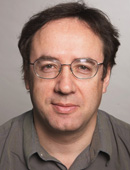
Sergei Y Sokol, PhD
About Me
Dr. Sokol's research is focused on signaling molecules regulating cell polarity and cell movements during vertebrate development. He also studies molecular mechanisms regulating neuronal differentiation of neural stem/progenitor cells.
Professor, Department of Developmental and Regenerative Biology
Member, Black Family Stem Cell Institute
Language
Position
Research Topics
Biochemistry, Brain, Cell Biology, Cell Motility, Cellular Differentiation, Cytoskeleton, Developmental Biology, Developmental Neurobiology, Epithelial Cells, Gene Expressions, Gene Regulation, Genetics, Growth Factors and Receptors, Image Analysis, Microtubules, Migration, Molecular Biology, Morphogenesis, Neurobiology, Notch Signaling, Nucleus, Protein Complexes, Protein Kinases, Protein Trafficking & Sorting, Proteomics, Receptors, Signal Transduction, Stem Cells, Trafficking, Transcription Factors, Transcriptional Activation and Repression
Multi-Disciplinary Training Areas
Cancer Biology [CAB], Development Regeneration and Stem Cells [DRS], Neuroscience [NEU]
About Me
Dr. Sokol's research is focused on signaling molecules regulating cell polarity and cell movements during vertebrate development. He also studies molecular mechanisms regulating neuronal differentiation of neural stem/progenitor cells.
Professor, Department of Developmental and Regenerative Biology
Member, Black Family Stem Cell Institute
Language
Position
Research Topics
Biochemistry, Brain, Cell Biology, Cell Motility, Cellular Differentiation, Cytoskeleton, Developmental Biology, Developmental Neurobiology, Epithelial Cells, Gene Expressions, Gene Regulation, Genetics, Growth Factors and Receptors, Image Analysis, Microtubules, Migration, Molecular Biology, Morphogenesis, Neurobiology, Notch Signaling, Nucleus, Protein Complexes, Protein Kinases, Protein Trafficking & Sorting, Proteomics, Receptors, Signal Transduction, Stem Cells, Trafficking, Transcription Factors, Transcriptional Activation and Repression
Multi-Disciplinary Training Areas
Cancer Biology [CAB], Development Regeneration and Stem Cells [DRS], Neuroscience [NEU]